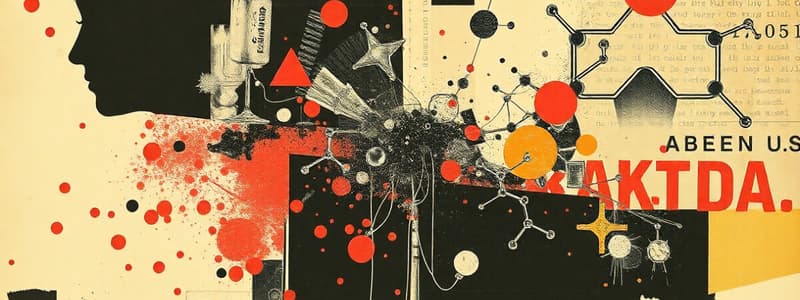Podcast
Questions and Answers
Which statement best describes the movement and arrangement of particles in a liquid?
Which statement best describes the movement and arrangement of particles in a liquid?
- Particles are arranged in a regular pattern and move freely.
- Particles are tightly packed in a fixed arrangement and vibrate in place.
- Particles are closely packed but can move past each other. (correct)
- Particles are widely spaced and move randomly at high speeds.
Diffusion occurs faster at lower temperatures due to the reduced kinetic energy of the particles.
Diffusion occurs faster at lower temperatures due to the reduced kinetic energy of the particles.
False (B)
Briefly explain the key difference between a mixture and a compound.
Briefly explain the key difference between a mixture and a compound.
In a mixture, substances are physically combined and retain their individual properties; in a compound, substances are chemically bonded in fixed ratios, forming a new substance with different properties.
The process of separating a solid from a liquid by passing the mixture through a porous material is known as ______.
The process of separating a solid from a liquid by passing the mixture through a porous material is known as ______.
Match the following separation techniques with the type of mixture they are best suited for:
Match the following separation techniques with the type of mixture they are best suited for:
Which subatomic particle determines the identity of an element?
Which subatomic particle determines the identity of an element?
Isotopes of an element have the same number of protons but a different number of electrons.
Isotopes of an element have the same number of protons but a different number of electrons.
Explain how the electronic configuration of an atom relates to its chemical properties.
Explain how the electronic configuration of an atom relates to its chemical properties.
When an atom loses electrons, it forms a(n) ______ with a ______ charge.
When an atom loses electrons, it forms a(n) ______ with a ______ charge.
Which of the following is a characteristic property of alkali metals?
Which of the following is a characteristic property of alkali metals?
Flashcards
3 States of Matter
3 States of Matter
Matter exists in three states: solid, liquid, and gas. Each state has unique arrangements and movement of particles.
Diffusion
Diffusion
The movement of particles from an area of high concentration to an area of low concentration.
Density
Density
Mass/volume ratio: how much 'stuff' is packed together
Element
Element
Signup and view all the flashcards
Compound
Compound
Signup and view all the flashcards
Mixture
Mixture
Signup and view all the flashcards
Atom
Atom
Signup and view all the flashcards
Molecule
Molecule
Signup and view all the flashcards
Filtration
Filtration
Signup and view all the flashcards
Evaporation
Evaporation
Signup and view all the flashcards
Study Notes
- The following topics are covered: Kinetic Particle Theory, Elements, Mixtures and Compounds, Purification, Atomic Structure and Electronic Configuration, and The Periodic Table.
Kinetic Particle Theory
- Matter exists in three states: solid, liquid, and gas.
- States of matter are differentiated by the arrangement and movement of particles.
- Diffusion is the process by which particles mix due to their random motion.
- Factors such as temperature affect the rate of diffusion.
- Heating and cooling curves illustrate the changes in temperature and state of a substance as it is heated or cooled.
Elements, Mixtures, and Compounds
- Elements are pure substances consisting of only one type of atom.
- Elements can be classified as metals or non-metals.
- Mixtures are combinations of substances that are physically combined.
- Compounds are substances formed from two or more elements chemically bonded.
- Key differences exist between mixtures and compounds, including how they combine and can be separated.
- Atoms are the basic building blocks of matter, and molecules are formed when two or more atoms join together.
- Polyatomic ions are ions composed of multiple atoms.
- Specific rules dictate how ionic compounds are named.
Purification
- Filtration is a method used to separate solid particles from a liquid.
- Evaporation involves converting a liquid into a gas to separate it from a solute.
- Crystallization is a process where solid crystals are formed from a solution.
- Distillation is used to separate liquids with different boiling points.
- Chromatography is a technique used to separate substances based on their different properties.
Atomic Structure and Electronic Configuration
- Atoms consist of a nucleus containing protons and neutrons, surrounded by electrons.
- The three main subatomic particles are protons, neutrons, and electrons.
- The number of protons, electrons, and neutrons can be calculated, as well as the atomic mass.
- Isotopes are atoms of the same element with different numbers of neutrons.
- Electronic structure and electronic configuration describe the arrangement of electrons within an atom.
- Ions acquire charges when they gain or lose electrons.
The Periodic Table
- Alkali metals are a group of elements found in the periodic table.
Studying That Suits You
Use AI to generate personalized quizzes and flashcards to suit your learning preferences.




